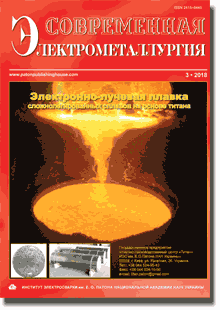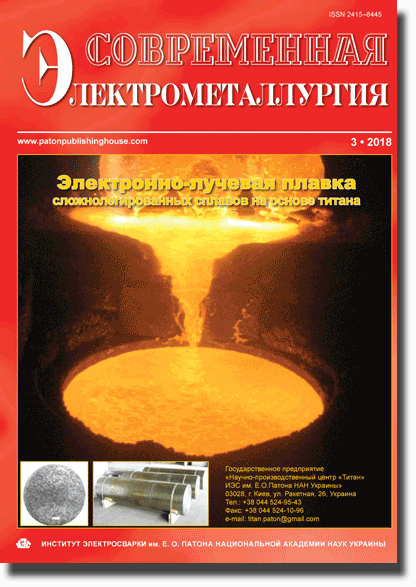| 2018 №03 (08) |
DOI of Article 10.15407/sem2018.03.01 |
2018 №03 (02) |

Electrometallurgy Today (Sovremennaya Elektrometallurgiya), 2018, #3, 8-15 pages
Producing of high-strength titanium alloy VT22 by method of electron beam melting
S.V. Akhonin1, V.A. Berezos1, A.N. Pikulin1, A.Yu. Severin1, S.L. Shvab1, A.G. Erokhin2
1E.O. Paton Electric Welding Institute of the NAS of Ukraine. 11 Kazimir Malevich Str., 03150, Kyiv, Ukraine. E-mail: office@paton.kiev.ua
2SE «RPC «Titan» of the E.O. Paton Electric Welding Institute of the NAS of Ukraine. 26 Raketnaya Str., 03028, Kyiv. E-mail: titan.paton@gmail.com
The integrated works were carried out on investigation of feasibility for producing ingots of high-strength complex-alloyed titanium alloy VT22 of a primary charge.. Using technology of an electron beam cold hearth remelting and a portion supply of metal into a water-cooled mould the ingots of 400 mm diameter and up to 3 m length were produced, from which the semi-products in the form of plates and hot-pressed rods of 60 mm diameter were manufactured. Results of investigations of structure and mechanical properties of semi-products, made of titanium alloy VT22 ingots. are presented. It was found that the metal of produced ingots and semi-products is in compliance with requirements of standards both by the chemical composition and also by the structure and mechanical properties. Moreover, the material is characterized by a good ductility at high strength characteristics. It is shown that the electron beam technology is an effective method for producing the complex-alloyed alloys of titanium. 12 Ref, 4 Tabl., 11 Fig.
Key words: вelectron beam melting; high-strength titanium alloy; ingot; chemical composition; structure; deformation; mechanical properties
Received: 06.11.17
Published: 01.10.18
References
- Khoreev, A.I., Khoreev, M.A. (2005) Titanium alloys, their application and prospects of development. Materialovedenie, 7, 25–34 [in Russian].
- Antonyuk, S.L., Molyar, A.G., Kalinyuk, A.N. et al. (2003) Titanium alloys for aircraft industry of Ukraine. Advances in Electrometallurgy, 1, 9–12.
- Bychkov, A.S., Molyar, A.G. (2016) Service load-carrying capacity of parts of structures of national transport category aircrafts from titanium alloys. Open Inform. i Komputer. Integr. Tekhnologii, 71, 18–29 [in Russian].
- Babenko, E.P., Dolzhenkova, E.V. (2014) Investigation of fracture causes of large-sized part of VT23 alloy. i Gornorudnaya Promyshl., 3, 82–85 [in Russian].
- Paton, B.E., Trigub, N.P., Akhonin, S.V., Zhuk, G.V. (2006) Electron beam melting of titanium. Kiev, Naukova Dumka [in Russian].
- Shambten, C.E. (1995) Titanium alloy hearth melt «only» technology development. Titanium 95. Science and Technology. In: of the 8-th World Conf. on Titanium (Birmingham, UK, October 22–26, 1995), Vol. 2, 1438–1446.
- Buttrill, W. H., Shambten, С. Е. (1995) Hearth melt plus vacuumarc remelt: production status. Ibid., 1446–1454.
- Poulsen, E., Chitmis, W., Made, M. (1999) Status of titanium cold hearth melting. Titanium 99. Science and Technology. In: of the 9-th World Conf. on Titanium (Saint-Petersburg, Russia, June 7–11, 1999), Vol. 3, 1328–1335.
- Akhonin, S.V., Severin, A.Yu., Berezos, V.A. et al. (2016) Peculiarities of melting of titanium alloy VT19 ingots in electron beam cold hearth installation. Elektrometall., 2, 23–27 [in Russian].
- Akhonin, S.V., Berezos, V.A., Pikulin, A.N. et al. (2014) Electron beam melting of surface of titanium alloy ingots. Ibid., 2, 21–25 [in Russian].
- Aleksandrov, V.K., Anoshkin, N.F., Bochvar, G.A. et al. (1979) Semiproducts of titanium alloys. Moscow, Metallurgiya [in Russian].
- Iliin, A.A., Kolachev, B.A., Polkin, I.S. (2009) Titanium alloys. Composition, structure, properties: Refer. Book. Moscow, VILS-MATI [in Russian].
The cost of subscription/purchase order journals or individual articles
| Journal/Currency | Annual Set | 1 issue printed |
1 issue |
one article |
| TPWJ/USD | 384 $ | 32 $ | 26 $ | 13 $ |
| TPWJ/EUR | 348 € | 29 € | 24 € | 12 € |
| TPWJ/UAH | 7200 UAH | 600 UAH | 600 UAH | 280 UAH |
| AS/UAH | 1800 UAH | 300 UAH | 300 UAH | 150 UAH |
| AS/USD | 192 $ | 32 $ | 26 $ | 13 $ |
| AS/EUR | 180 € | 30 € | 25 € | 12 € |
| SEM/UAH | 1200 UAH | 300 UAH | 300 UAH | 150 UAH |
| SEM/USD | 128 $ | 32 $ | 26 $ | 13 $ |
| SEM/EUR | 120 € | 30 € | 25 € | 12 € |
| TDNK/UAH | 1200 UAH | 300 UAH | 300 UAH | 150 UAH |
| TDNK/USD | 128 $ | 32 $ | 26 $ | 13 $ |
| TDNK/EUR | 120 € | 30 € | 25 € | 15 € |
AS = «Automatic Welding» - 6 issues per year;
TPWJ = «PATON WELDING JOURNAL» - 12 issues per year;
SEM = «Electrometallurgy Today» - 4 issues per year;
TDNK = «Technical Diagnostics and Non-Destructive Testing» - 4 issues per year.





